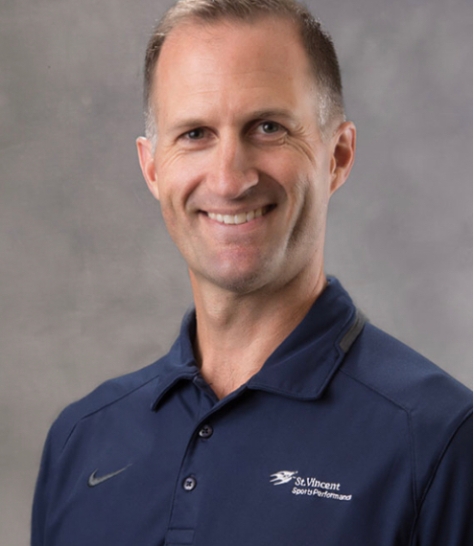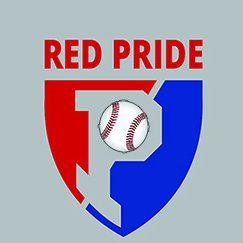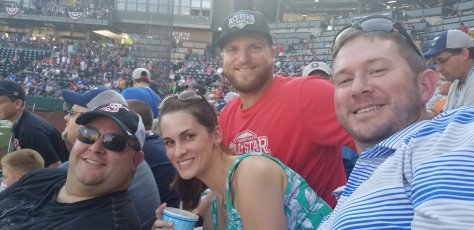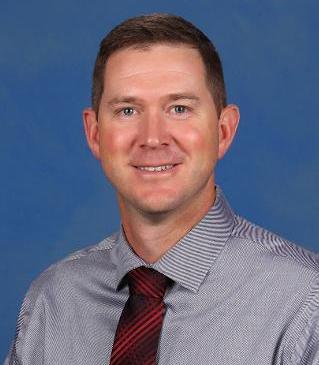
BY STEVE KRAH
Ryan Harber was a left-handed pitcher at Fort Wayne (Ind.) Northrop High School, Butler University and in the Florida Marlins system. He was selected in the seventh round of the 1999 Major League Baseball First-Year Player Draft and played five minor league seasons.
He has taken his experiences as an athlete, student and 17 years as a Certified Athletic Trainer and Strength Coach at Indianapolis-based St. Vincent Sports Performance (he works out of the Carmel location) to help athletes in many sports, including baseball.
Harber shared his knowledge on “Assessing the Overhead Athlete” at the first PRP Baseball Bridge The Gap Clinic in Noblesville as a guest of Greg Vogt.
The pyramid for “ideal athlete” development as Harber presents it has movement at the base with performance in the middle and skill at the top.
“Every athlete should have a wide range of movement,” says Harber.
Movement involves the ability to squat, lunge, bend, extend along with single-leg stability, shoulder mobility, trunk stability and rotary stability.
“It’s everything Greg works on in his program,” says Harber. “It’s everything a strength coach works on.”
Performance includes speed, strength, power, agility, endurance, reactivity and quickness.
Skills are sport-specific, such as working on throwing mechanics or taking cuts off the tee.
“Where we get out-of-balance is when we focus too much on the skills and the performance and not enough on your fundamental movements,” says Harber.
“This movement becomes dysfunctional when you have poor range of motion, or a lack of stability.”
Harber says among his goals is to minimize injuries and maximize potential.
“You can’t make the team if you’re stuck in the training room,” says Harber. “You’re not going to help the team if you can’t stay healthy.
“Your durability is more important than your ability.”
Resiliency is the ability to bounce back from a difficult condition.
“Everything you do in life is managing risk,” says Harber. “You guys took a risk, getting out of the house, getting in your car and coming over here. You could have got into an accident.
“What did you do to minimize that risk? You put your seat belt on.”
Harber says the system as it currently stands does not work in players’ favor.
At 43, Harber came up before travel baseball became what it is today.
There was some American Legion and Connie Mack ball in the summer.
“You guys play 50, 60, 70 games a year right now just in travel ball,” says Harber. “On top of that comes your high school season. Then you may take three weeks off in August right around tryouts for the next travel ball season then you go play fall ball.
“It’s too much. Your bodies can’t handle that at this age.”
Harber says most pain — outside of direct blows or trauma — will seem
to appear suddenly.
“In fact, it’s been building up for years,” says Harber. “Your body is able to compensate and adapt.
“The day that your pain shows up is simply the day that your compensation ran out. Try to start thinking of pain as a request for change. It’s your body’s way of saying, ‘I can’t do it anymore.’”
Harber presented findings from the American Journal of Sports Medicine:
If a pitcher pitches while fatigued, there’s a 36 times increased risk of injury.
• Pitchers lose 6-18 percent of rotator cuff strength after one game.
“Recovery is important,” says Harber.
• Pitchers lose 3-4 percent of rotator cuff strength over the course of one season.
• Throwing more than 75 pitches in a game yielded a 2.5 times greater chance of shoulder pain.
What is the cumulative effect (according to the AJSM)?:
• Pitching for greater than eight months out of the year results in
five times as many injuries.
• Pitching greater than 100 innings in one year results in three times as many injuries.
• Pitching showcases and travel leagues significantly contributed to increased injuries.
• Throwing more than 600 pitches per season yielded a 3.5 times greater chance for elbow pain.
In addressing performance, Harber notes the following:
• The peak age for a baseball player is 27.
“It’s not 18 or 21,” says Harber. “It takes time to develop these players.”
• Typical MLB pitcher is 6-5, 250 pounds.
• Starters 200-plus innings per year.
• Starters throw 3,500 pitches.
• There make 30-35 starts.
• They throw 35 bullpens.
“Injuries are going to happen,” says Harber. “Every pitcher has been hurt, is hurt, will be hurt at some point in their career.
“To be able to withstand that, you have to train. You have to manage that fatigue. You have to recover. All that stuff’s important.”
Harber also talked about the importance the Central Nervous System plays in the whole equation.
“Central Nervous System is king,” says Harber. “It controls everything.
“Without proper motor control, your nervous system doesn’t feel safe.
If it detects a threat it will not give you freedom of movement. It will not let you put force through a joint.”
CNS grants strength and mobility.
“Potential strength is always there, but the brain won’t give it to you if it feels vulnerable,” says Harber. “The brain is always asking itself, ‘Is giving you more strength right now a good idea?’ If the
answer is no, you aren’t getting it no matter how much you want it.
“Your nervous system will only let you go as fast, hard and heavy as it knows you can slow.”
Harber says there is no such medical definition for a “dead arm.”
“It’s the nervous system,” says Harber. “Your brain detects an instability somewhere and it’s not going to let you put force through that.”
Addressing mobility (the ability to move or be moved freely and easily) and stability (the resistance to movement) can help diagnose many issues.
With poor scapular stability, the body locks down the thoracic spine and should range of movement.
When there’s poor core stability, the body locks down the SI joint to find stability/strength.
If there’s poor mid-foot stability, the body collapses the arch and up the joint to create a rigid structure to push off of.
“You were born with all the mobility in the world,” says Harber. “You earn stability and we mess it up along the way due to poor posture, past injuries and faulty movement patterns.
“I’ve got a 7-month old baby at home. He’s like Gumby. I can bend him, and he won’t break. He’s trying to figure it out developmentally.
“I can stand him up and he becomes a Starfish. He locks out his legs and
his shoulder blades. That’s his body trying to create artificial stability.”
During a five-year period of working with youth players while in Atlanta, Harber collected data and found a number of players with shoulder mobility asymmetries with at least a 6 inch difference
between the right and left.
The number of asymmetries went up as the players got to be 16, 17, 18.
“Why?,” says Harber. “More games. The more you throw, the more imbalances are going to happen.”
On top of that, older players are beginning to get into the weight room, lifting heavier loads and getting tighter.
“If they don’t have somebody addressing mobility and stability along the way, they are going to create more issues,” says Harber.
A joint by joint feet-to-fingertip assessment (going up the kinetic chain) includes:
• Foot stability.
• Ankle mobility.
• Knee stability.
• Hip mobility.
• Lumbar stability.
• Thoracic spine mobility.
• Scapular stability.
• Shoulder (gleno-humeral) mobility.
• Elbow stability.
• Wrist mobility.
“Mobile. Stable. Mobile. Stable,” says Harber. “They stack on top of
each other.
“When that pattern is broken, injuries happen.”

Ryan Harber, who pitched at Fort Wayne (Ind.) Northrop High School, Butler University and in the Florida Marlins organization, has been a Certified Athletic Trainer and Strength Coach with Indianapolis-based St. Vincent Sports Performance for 17 years.



